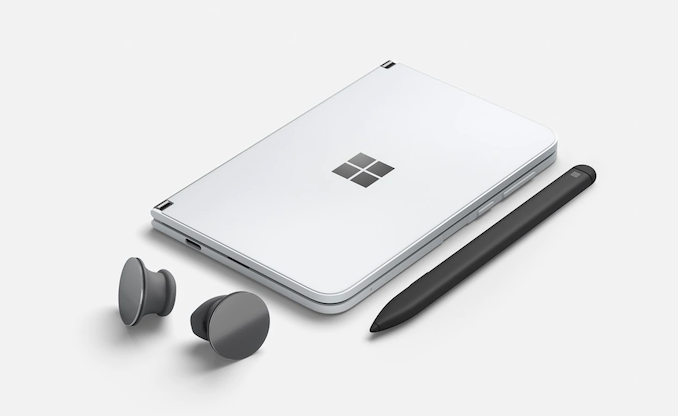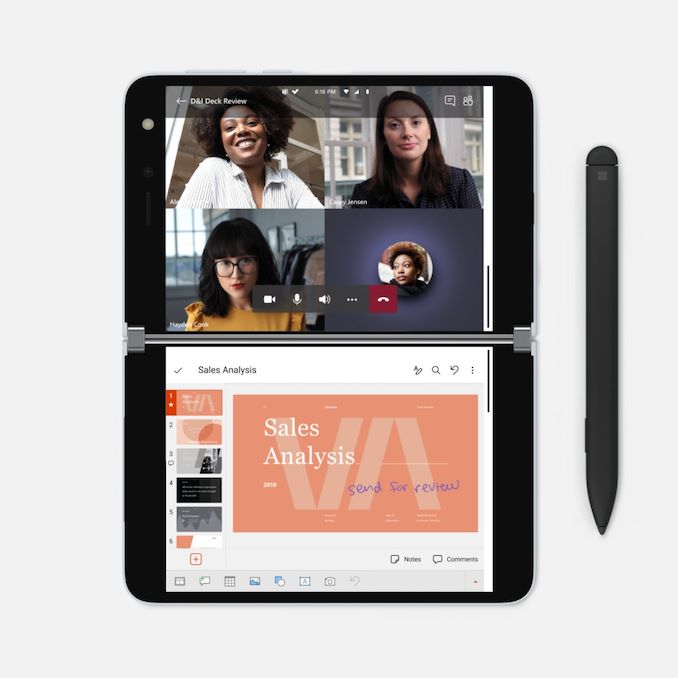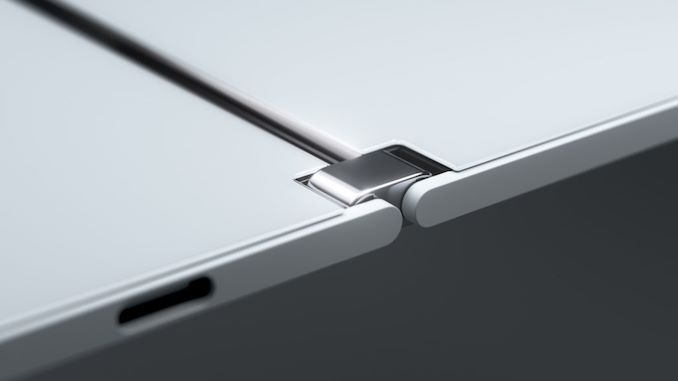Microsoft Opens Pre-Orders for Surface Duo - US Only
by Andrei Frumusanu on August 12, 2020 10:30 AM EST
Late last year in October, Microsoft had announced the Surface Duo, the company’s first ever Android device and first-party smartphone (if you can call it that) release in years. What makes the Surface Duo special is its symmetric dual-screen nature and 360° hinge mechanism that allows the device to fold itself shut like a book – to fully opening itself up with two opposing displays. Today Microsoft is finally making the Surface Duo available for pre-order – although availability will be limited to the US.
| Microsoft Surface Duo | ||
| Surface Duo | ||
| SoC | Qualcomm Snapdragon 855 1x Kryo 485 (Cortex-A76) @ 2.84GHz 3x Kryo 485 (Cortex-A76) @ 2.42GHz 4x Kryo 485 (Cortex-A55) @ 1.80GHz Adreno 640 @ 585MHz |
|
| DRAM | 6GB LPDDR4X | |
| Display | Dual 5.6" solid OLED with 360° hinge 1800 x 1350 (4:3) Unfolded 8.1" effective diagonal at 2700x1800 (3:2) |
|
| Size | Height | 145.2 mm |
| Width | 93.3 mm (closed) - 186.9 mm (open) | |
| Depth | 9.9mm (closed) - 4.8 mm (open) | |
| Weight | 250 grams | |
| Battery Capacity | 3577mAh total (dual cells) | |
| Wireless Charging | - | |
| Rear Cameras | ||
| Main | 11MP 1.0 µm f/2.0 |
|
| Telephoto | - | |
| Wide | - | |
| Extra | - | |
| Front Camera | - | |
| Storage | 128 / 256 GB UFS 3.0 | |
| I/O | USB-C | |
| Wireless (local) | 802.11ac Wave 2 Wi-Fi Bluetooth 5.0 LE + NFC |
|
| Cellular | (Category 12/5) DL = 1200Mbps 5x20MHz CA, 256-QAM UL = 150Mbps 2x20MHz CA, 64-QAM |
|
| Other Features | It folds | |
| Dual-SIM | 1x nanoSIM + eSIM | |
| Launch Price | $1399 | |
Starting off with the uninteresting stuff – the internal hardware of the Surface Duo isn’t all that exciting as it features a last generation Snapdragon 855 SoC. Given the device’s early announcement last year it seems Microsoft took a long time to bring the device to market. We’re seeing a standard amount of DRAM and storage space with 6GB and either 128GB or 256GB options. All in all there’s nothing too special about the internals here and are in line with 2019 flagships.
The device’s key characteristic is naturally its symmetrical folding design with two 5.6” 1800 x 1350 resolution OLED screens. Although we call this a folding device, this doesn’t actually apply to the displays as they’re two distinct units covered with solid glass.
Further unique to the design is the hinge mechanism which is symmetrical as well – it allows for a full 360° tilt of the two sides, meaning you can have the device either fully shut, or you can have it fully opened with both screen facing outwards.
Microsoft opted for relatively unusual form-factors here as the screens are each 4:3 – and when opened up it gives you a sort of effective 8.1” diagonal 3:2 surface to work with.
The dimensions of the device come at 145.2mm height in portrait mode, and one side is 93.3mm wide, which opens up till 186.9mm. Each half is extremely thin at only 4.8mm meaning that even when folded it remains a relatively reasonable 9.9mm in thickness.
The device’s 360° folding nature means that the internal screen surface can face completely outwards, and Microsoft took advantage of this for their camera design, of which the Surface Duo only has a single unit. The 11MP 1µm pixel f/2.0 standard wide-angle unit is relatively conservative in specifications, but that’s the compromise that had to be made to fit into a 4.8mm thick chassis and not having the possibility to employ a camera bump.
Microsoft positions the Surface Duo as a productivity device, and its first-party applications such as the Microsoft 365 suite will be optimised for the experience. This seemingly will be the deciding factor as to how the Surface Duo will be received, as it represents quite a niche device market.
The Surface Duo is available for pre-order now at a very high price of $1399, with availability only in the US and compatibility with AT&T, T-Mobile and Verizon, with availability starting September 10th.
The device’s high price and relatively lacklustre specifications will likely result in limited adoption amongst users- and the device in general feels more like an experiment than a product that’s aimed at commercial success.













71 Comments
View All Comments
ozzuneoj86 - Wednesday, August 12, 2020 - link
I haven't been following this product at all. For $1400 I thought it'd have some previously-unknown x86 SoC and be running Windows 10.I honestly wish they'd make a phone that ran full-Windows. Have a "phone" type default application that loads for accessibility to common phone functions, but leave the rest to Windows. Give it a stylus, foldable with a keyboard. Maybe have it usable as a basic phone (answering calls, checking messages, etc) without opening it for ease of use...
Someone make this and I will buy it (once it's two years old and is somewhat affordable).
damianrobertjones - Tuesday, August 18, 2020 - link
Not many 'standard' consumers would buy it and the press would destroy it.sharathc - Wednesday, August 12, 2020 - link
Very interesting part of the article was,"Other features: It folds"
😄
sonny73n - Thursday, August 13, 2020 - link
Can this device be used by 2 persons separately, each to their own screen? If not, what’s the need for the other screen that’s facing away from the user? Either way, it’s a terrible design, not to mention the outrageous price tag.damianrobertjones - Tuesday, August 18, 2020 - link
Let's say that you're watching a film, with your friend wishing to chat with you. With this, you can do both without side-by side reducing the app/task to a small side of the same screen.Imagination is a wonderful thing.
wrkingclass_hero - Thursday, August 13, 2020 - link
I hope this flopps hard so I can get one for cheapdamianrobertjones - Tuesday, August 18, 2020 - link
I hope it sells which should mean that others will adopt the format and then we'll see top/middle/bottom of the range devices.Kevin G - Thursday, August 13, 2020 - link
So after a decade, the MS Courier is finally getting a release.Ah, another notch in MS's history of missed opportunities.
damianrobertjones - Tuesday, August 18, 2020 - link
It was released. Toshiba W100.KimGitz - Friday, August 14, 2020 - link
(Multiple Screens vs Folding Screens) vs (Multiple devices)This device edges ever closer to the dream of using one device that can morph from a smartphone in my pocket, to a tablet in my hands to a computer on my lap or desk.
I wish this was just one screen but the current technology for folding screens is still not convincing. We are just getting to a place where we got the tablet/laptop 2in1 working well. Merging touch and pen interface with a mouse and keyboard interface is still not perfect but that is easier compared to having something that functions well as a smartphone and tablet because while we carry both the tablet and the laptop in a bag, carry the smartphone in our pockets.
The beauty of having one device with multiple functionality is the synergy in software. With multiple devices I have to worry about compatibility and ecosystems. More than the device form factor is the begining of hopefully better compatibility between Android and Windows, Google and Microsoft. It is a breath of fresh air seeing such collaborations. We still have to endure using multiple devices that can be on different ecosystems for the near future so it is good to be able to transition between devices seamlessly.
I'd love Google to incorporate most if not all the software features here not just for duo screen phones but also for tablets with one screen on split screen mode.